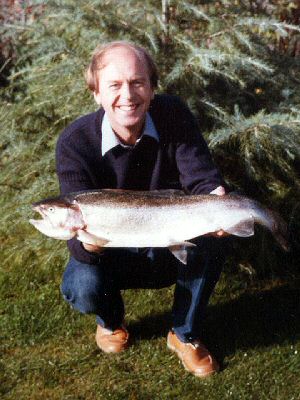The Orange Cats Whisker Streamer Lure
Do you go fly fishing on large lakes or reservoirs? If yes I bet you use a selection of nymphs tied on to droppers. There are other options including using streamer fly patterns like the Cats Whisker Streamer Lure

CAT'S WHISKERS STREAMER FLY PATTERNS. Hook size 8 10 - $US each
The Orange Cats Whisker Streamer Lure was invented by the English fly fisherman David Train in the 1980's. That is his photograph on the right. All our Cats Whiskers are sent to us direct from David so you can boast to your friends you have a David Train Cats Whisker. When fishing from a boat on a large lake or reservoir, I like to use 9ft 6inch to 10 foot rod rated at a 7-wt or 8-wt. I find having a longer rod gives me more control of the line when playing trout at long range. It also helps give you extra height when casting whilst sitting down in the boat. I use leader material of about 5lbs to 6lb breaking strain just in case I encounter the odd over wintered trout that wants to give me a fight. The most important bit of kit is your life jacket. You are fishing on deep water. You may be the strongest swimmer in the country but that skill it will not help you if you get accidently knocked unconscious by a badly controlled heavy wooden row boat oar.
The basic diet of large still water trout and grayling throughout the year consist mainly of nymphs supplemented by the occasional small fly. These aquatic mayfly and caddis nymphs can be found in the water to the depths of 35 feet+. They spend most of their time near the bottom except when they have been dislodged by stronger than normal currents, feeding fish or are rising towards the surface to hatch.

When I arrive at a new reservoir or lake I like to identify where the inlet stream is located. I find this is a good place to start, especially on hot summer days, because the new wager entering the system is fresh and rich in oxygen. The modern way to fish large lake or reservoir is to use a team of flies. There will be one that floats on the top of the water surface that can be used as a strike indicator. You can have between one to three flies fishing different depths under the buoyant dry fly. These subsurface flies are called droppers. The combinations you can tie onto your leader are endless. You can mix wet flies with epoxy buzzers and nymphs. The most important thing to remember I that the heaviest fly should be at the end of your rig. This is called the point fly. It will help with casting out your team without them getting all tangled up. The heaviest fly sinks quickly and straightens out your leader so the other droppers fish correctly and start to fish at different depths rather than one tangled mess.
A good tip I learnt long ago was when using an anchor, to tether it in the middle. This ensures that the wind is from your back and this makes casting easier. I start off with a 15 foot leader length with droppers about two feet apart. I find when fishing from a boat I use two droppers plus a point fly. In the early part of the year I find black and green lures are effective. Flies like a viva woolly bugger or a black and light green Montana work well. Midseason I use a bead head Gold Ribbed Hare’s Ear Nymph as a point fly with pheasant tail nymphs on the middle droppers.
Sometimes it can be difficult to find out what flies the trout will take, especially if it is a hot day. If there are two of you in the boat work as a team. If your normally successful rig of GRHE and pheasant tail nymphs is not getting any hits than one of you tie on some Epoxy buzzers whilst the other ties on streamer lures like one of David Train’s Cat’s Whiskers, a black or olive Woolly Bugger, Zonker or Muddler minnow.
Consider moving to a new location. Look for a wind lane. This is an area on the water surface that because of the surrounding vegetation or contours of the hills, is being disturbed more by gusts of wind that other parts. You want to fish the crease. This is the line between the choppy rippled water and the calmer area. You need to change your tactics for fishing a wind lane edge. The trout are cruising just under the surface in the hope of mopping up insects that have been smothered and drowned by the turbulent water. In the heat of summer the water can become oxygen starved. Some fishery lakes and reservoirs have installed air lines to maintain the quality and health of the fish. This is a good location to move towards if you are having problems locating feeding fish in other parts of the water system.


Fly Fishing books





